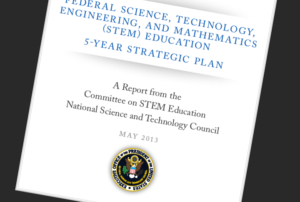
In a recent report, CoSTEM identifies the need to “Support a 50 percent increase in the number of U.S. youth who have an effective, authentic STEM experience each year prior to completing high school.”[1] By “authentic STEM experience,” CoSTEM refers to an experience inside or outside of the classroom in which learners engage directly in science, technology, engineering, and maths. This broad designation covers a range of commonly referenced activities, from hands-on science, to problem-based learning, to active inquiry.[1]
Recent research [2,3,4] also points to active, engaged learning in which students interact with the teacher, other students, and the target phenomena to derive meaning, to construct an understanding of the world around them. SIMOC is a dynamic vehicle for this kind of explorative learning and study. At its fundamental level, SIMOC engages students in the 8 Science and Engineering Practices described in the NGSS[5]:
- Ask questions about how variables in the model configuration affect success in achieving the desired outcome.
- Develop and use the SIMOC model to test various design solutions.
- Plan the investigation then launch and monitor the SIMOC simulation to its conclusion.
- Analyze and interpret the data using the built-in visual aids (input variables, mission clock, gauges for atmosphere composition, water, food, and power versus astronaut health; and
- Using mathematics and computational thinking, engage a deeper understanding through statistical and machine learning (AI) tools applied to the data.
And in the formal education environment, the final 3 Practices are integrated into the lesson:
- Construct explanations (for science) and designing solutions (for engineering).
- Engage in argument from evidence.
- Obtain, evaluate, and communicate information.
“Similarly, an engaging and effective science education goes well beyond the low-level factual recall that is emphasized in many science classes. It must develop the skills that students need to solve complex problems, work in teams, make and recognize evidence-based arguments, and interpret and communicate complex information.”[6]
Taking into account the most recent research and a deep understanding of what has and has not worked in education, the Framework for K-12 Science Education calls for learning to be built around 3-dimensions:
- Science and engineering practices,
- Crosscutting concepts that unite science, and
- Disciplinary Core Ideas.
One of the most critical aspects of authentic STEM experiences is the careful structuring of the activities to engage the students in “(a) the major practices that scientists employ as they investigate and build models and theories about the world, and (b) a key set of engineering practices that engineers use as they design and build systems.”[4]
The 3-dimensional learning of Next Generation Science Standards (NGSS) is being called Phenomena-based Learning. The SIMOC team has at its disposal an existing, well-developed phenomenon that engages students in authentic science and engineering, where SIMOC’s function as a real-world research tool ensures authenticity. With careful construction of supporting curricular materials, students will be engaged in all NGSS practices through constructing and understanding the phenomenon.
It is important that experienced education professionals work with SIMOC developers to engender these experiences, ensuring the full intent of NGSS. In this context the NGSS Phenomena-based Learning, Constructivism[7], and Exploration Learning are describing the same authentic activities that facilitate creation of understanding by the students.
Similar, extant curricula includes ASU’s Mars Student Imaging Project and other MarsEd programs that Don Boonstra (SIMOC’s curriculum developer) helped align to NGSS for NASA. All use authentic research environments and NASA data to engage students in understanding critical phenomena, and developing understanding of critical, core concepts in science and engineering.
In this respect, we have a proven road map for SIMOC’s success.
References
- Committee on STEM Education National Science and Technology Council. (May 2013). Federal Science, Technology, Engineering, and Mathematics (STEM) Education 5-Year Strategic Plan [PDF]
- National Research Council. (2005). How Students Learn: History, Mathematics, and Science in the Classroom. Washington, DC: National Academies Press.
- National Research Council. (2007). Taking Science to School. Washington, DC: National Academies Press.
- National Research Council (NRC). 2012. A framework for K–12 science education: Practices, crosscutting concepts, and core ideas. Washington, DC: National Academies Press.
- Science and Engineering Practices in the NGSS, April 2013 [PDF]
- President’s Council of Advisors on Science and Technology. (September, 2010). Prepare and inspire: K-12 education in science, technology, engineering, and mathematics (STEM) for America’s future. [PDF]
- Constructivism. [website]
Introduction | Classroom Lessons (NGSS) | Classroom Examples | Formal Learning

